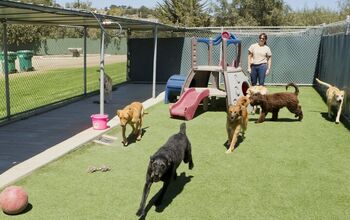My Dog Broke A Nail, Now What?

Seeing your pup showing signs of pain is never easy, and the sight of blood can be particularly alarming. While a broken nail may not seem like a major source of alarm, that one small injury can introduce a lot of discomfort (and blood). But take a deep breath; you’re not alone in facing this common struggle.
This blog post is designed to be an informative guide, walking you through the essential steps to take when your dog breaks a nail to relieve pain and prevent further complications. With the proper knowledge and a little care, most broken nail situations can be managed effectively, allowing your pup to get back on their paws in no time.
First Aid for Dog Nail Injuries
When you discover your dog has broken a nail, remain calm. Your dog may be in pain and feeling anxious. By staying calm and composed, you will help prevent further distress and avoid a possible accidental injury to you.
Speak in a soothing voice and move slowly. If your dog is particularly sensitive to pain or tends to react defensively when hurt, you may wish to enlist the help of another person to gently restrain them. In situations where you’re concerned about being bitten, having a properly fitted muzzle on hand can ensure everyone stays safe while you administer first aid.
Stop the Bleeding
Broken nails often bleed because they contain a blood vessel known as the quick. You'll likely see some blood if the break occurs above this point. The first step in managing this injury is to stop the bleeding quickly.
When dealing with any type of bleeding, your first line of defense is to apply direct pressure. Use a clean cloth or a piece of gauze and firmly press it against the bleeding nail for several minutes, often longer than you may initially think. Resist the temptation to check frequently, as removing the pressure can disrupt the clotting process.
For persistent bleeding, styptic powder or a styptic pencil is an effective solution. We ensure we always have at least one of the two in our pet-friendly first aid kit. Styptic powder contains ingredients that help constrict blood vessels and promote clotting. To use it, apply a small amount directly to the bleeding area of the nail. A styptic pencil works similarly; wet the tip slightly to activate it and gently press it against the bleeding directly.
If you don’t have styptic powder or a pencil on hand, some common alternatives that dog parents will reach for are cornstarch and flour. They can help absorb blood and encourage clotting. The easiest way to use these is to put some into a small container and then place the broken nail in it, maintaining pressure to give the blood time to clot. Remember, patience is key during this step; the bleeding may take several minutes to stop.
Assessing the Damage
Look closely at the broken nail once the bleeding has stopped or significantly slowed. Is it a clean break near the tip? Is it a partial tear that’s still attached? Is the quick exposed, leaving a raw and sensitive area? Take note of any visible debris, such as dirt, splinters, or fragments of the nail itself.
Your findings will help you decide on the best course of action to prevent further damage and whether you need to contact your vet.
Initial Cleaning (If Possible and Safe)
If your dog tolerates examining their paw and the bleeding is under control, you may be able to gently clean the area. Use lukewarm water to carefully rinse the paw and the broken nail. This can help to remove any loose dirt or debris that may be there.
Avoid using any harsh antiseptics like hydrogen peroxide or alcohol at this stage, as they can be irritating to the exposed injury and potentially delay healing. The goal of this initial cleaning is simply to remove any obvious dirt that could contribute to further pain and discomfort. Your vet can do a more thorough cleaning if necessary.
Understanding the Risks of Dog Nail Injuries
While the immediate sight of blood from a broken nail can be alarming, the potential risks extend beyond this initial shock. Here are a few additional risks to be aware of:
Pain and Discomfort
Even if you manage to stop the bleeding quickly, your dog can still experience significant pain and discomfort. The nail bed contains sensitive nerve endings, and a break, especially if it leaves the quick exposed, can create a very painful situation for your pup. Every time your dog puts pressure on the affected paw, they may feel a sharp or throbbing pain, leading to limping or a reluctance to walk or put weight on that leg.
Infection
A break in the nail creates an open wound, providing an entry point for bacteria and fungal organisms that they may encounter in the environment. Simple things like walking on the ground, contact with dirt and debris, or even your dog’s own licking can introduce pathogens into the wound.
Recognizing the signs of infection is crucial to addressing it as quickly as possible. Keep an eye out for the following red flags:
- Redness
- Swelling around the nail bed
- Pus or discharge
- Increased pain or sensitivity
- Warmth to the touch
- Fever
- Lethargy
Partially Broken Nails
A partially broken nail poses its own set of risks to your pup. The jagged edge can easily catch on carpets, furniture, or outdoor surfaces, leading to further tearing of the nail and increased pain for your dog.
Ongoing Irritation of the Area
The irritation and discomfort can also trigger excessive licking or chewing at the affected paw. While your dog may be trying to soothe their pain, this behavior can make the problem worse by introducing more bacteria and potentially leading to self-inflicted wounds around the paw.
Mobility Concerns
In more severe cases, a broken nail can significantly impact your dog’s mobility. The pain and discomfort can make it difficult for them to engage in their usual activities, such as walking, running, and playing. This not only impacts their physical well-being but can also negatively impact their overall happiness and quality of life. Imagine being a high-energy dog who no longer has a safe outlet for all that energy.
When to Call Your Veterinarian
While many minor broken nail injuries can be managed at home with proper first aid, there are some situations where your vet's help is crucial for your dog’s well-being and to prevent further complications. Knowing when to make that call can save your dog from unnecessary pain and potential long-term issues.
Here are a few key indicators that it’s time to pick up the phone and make a call:
- Uncontrollable Bleeding: If you’ve applied direct pressure to the broken nail for 10-15 minutes and the bleeding hasn’t stopped or significantly slowed down, this should be considered a medical emergency. Persistent bleeding could indicate a more severe injury or an underlying clotting issue.
- Severe Breaks or Exposed Quick: When a significant portion of the nail is missing or the quick is deeply exposed and appears raw, it’s generally best to have a vet check it out. These types of breaks can be very painful and are more prone to infection. Professional cleaning and pain management are usually necessary to prevent complications and ensure it heals properly.
- Signs of Infection: As mentioned earlier, infection is a significant risk with broken nails. A veterinary visit is warranted if you observe any of the signs of infection we listed above.
- Significant Pain or Lameness: While some mild discomfort is expected with a broken nail, if your dog is showing signs of severe pain, such as excessive whining, reluctance to move, guarding the paw, or showing significant limping that doesn’t improve with rest, it’s time to see a vet. They can assess the extent of the injury and provide much-needed pain relief.
- Embedded Debris: If you notice dirt, splinters, or other debris embedded in the nail bed that isn’t removed easily by rinsing the injury with water, it’s best to have a veterinarian handle it. Attempting to remove deeply embedded objects can cause further injury and increase the risk of infection.
- Multiple Broken Nails: If your dog suddenly breaks multiple nails at once, this could be a sign of an underlying health issue or a specific, more serious incident that requires vet investigation to determine the cause and appropriate treatment.
- Dog’s Temperament: If your dog is in so much pain or is so anxious that they won’t allow you to examine the injury or provide first aid safely, it’s best to take them to the vet ASAP, rather than trying to address it at home. Forcing the issue could lead to you getting bitten or further stressing your dog.
What to Expect at the Vet
When you bring your dog in for a broken nail, your vet will thoroughly examine the affected paw. They may gently clean the area with a medical-grade antiseptic solution and trim any remaining jagged edges of the nail to prevent further snagging or injury.
Depending on the severity of the break and the level of pain your dog is experiencing, the vet may apply a bandage to protect the area and provide pain medication. If there are signs of infection or a high risk of it, your vet may also prescribe antibiotics.
In some cases, they may discuss potential underlying causes for the nail breakage, especially if this is a recurring issue. That way, you can address the underlying problem and hopefully prevent future problems.
Prevention is Key to Healthy, Happy Paws
While knowing how to respond to a broken nail is essential, prevention is always the best approach to any injury. After all, no one wants to see their pup in pain. Consistent care and attention to your dog’s paws can contribute significantly to their overall well-being and keep them happily on the move.
Regular Nail Trimming
Regular nail trimming is one of the most important steps to prevent broken nails. When a dog’s nails grow too long, they become more susceptible to snagging on various surfaces, leading to breaks, tears, and even the painful tearing of the quick.
It is recommended that you trim your dog’s nails every few weeks, but this will vary from dog to dog. Always use appropriate clippers when trimming, whether you prefer the guillotine or scissor styles, ensuring they are sharp for a clean cut. Learn how to spot the quick within the nail, allowing you to trim the nail back a safe distance without cutting it.
This is particularly important for dogs with dark nails, where the quick is not easily seen. In these cases, it’s best to trim small amounts at a time, stopping as soon as you see a chalky white ring appear on the cut surface of the nail. This ring indicates you’re getting close to the quick.
As I already stated, it’s always wise to have styptic powder on hand during nail trims, just in case you accidentally cut the quick.
If you feel uncomfortable or unsure about trimming your dog’s nails yourself, that’s okay! Don’t hesitate to use the services of a professional groomer or your vet. They have the expertise and experience to trim your dog’s nails safely and can also provide guidance on the proper technique. We trim one of our dogs’ nails at home while the other goes to a groomer for her nail trims due to the anxiety it brings her.
Appropriate Exercise Surfaces
The surfaces your dog walks and plays on can help impact their nail health. Walking on hard surfaces like concrete or asphalt can help naturally wear down their nails over time, reducing the need for frequent trimming. However, you should approach running on very rough terrain, like rocky or uneven surfaces, with caution, as these surfaces can increase the risk of nail breaks or damage.
Good Nutrition
While not a direct solution to preventing nail breaks, good nutrition plays a role in the overall health and strength of your dog’s nails. A balanced diet that provides essential vitamins and minerals contributes to healthy nail growth and can potentially make them less brittle and prone to breaking.
Environmental Awareness
Being aware of potential hazards in your dog’s environment can also help prevent broken nails. Look out for things like loose floorboards, sharp objects lying around, or areas where your dog’s nails could easily get caught, such as gaps in decking or fencing. Taking steps to minimize these risks can help keep their paws safe.
Regular Paw Inspections
Make it a habit to inspect your dog’s paws and nails regularly. This only takes a few moments and allows you to identify issues early on, such as small cracks, splinters, or overgrown nails. Catching these problems early will help you prevent them from developing into something more serious. If you notice a crack in a nail, for example, you can take extra care to keep it clean and trim back any jagged edges or pieces that could potentially catch or snag, causing it to break further.
Consider Paw Protection (In Some Situations)
Paw protection, like a high-quality pair of dog boots, can be a valuable preventive measure in certain situations. If you frequently hike with your dog on rough or rocky trails, or if they are exposed to extreme weather conditions like jagged ice or very hot pavement, boots can offer a protective barrier for both their paws and their nails, reducing the risk of injury. While this isn’t necessary for everyday walks for most dogs, they are a helpful tool in specific circumstances.
Protect Your Dog’s Nails Today!
Dealing with a broken nail can be a stressful experience for any dog parent. By arming yourself with the knowledge of how to respond effectively and, more importantly, how to prevent an injury from happening, you can keep your pup safe from unnecessary pain and discomfort.
Remember, routine nail care, including regular trimming, paw exams, and being mindful of environmental hazards, can play a significant role in keeping your dog’s paws healthy and reducing the likelihood of a broken nail. A little consistent care and due diligence will go a long way in ensuring your pup can continue to explore the world in comfort. Isn’t that ultimately what we all want?
Join the PetGuide community. Get the latest pet news and product recommendations by subscribing to our newsletter here.

Britt Kascjak is a proud pet mom, sharing her heart (and her home) with her “pack” which includes her husband John, their 2 dogs – Lucifer and Willow – and their 3 cats – Pippen, Jinx, and Theia. She has been active in the animal rescue community for over 15 years, volunteering, fostering and advocating for organizations across Canada and the US. In her free time, she enjoys traveling around the country camping, hiking, and canoeing with her pets.
More by Britt
























